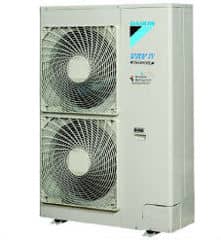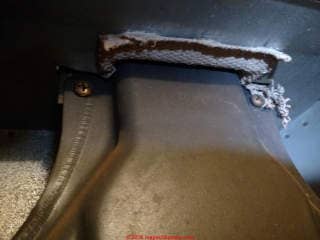 Asbestos HVAC Ducts FAQs#3
Asbestos HVAC Ducts FAQs#3
Q&A on Asbestos In Heating / Cooling Ducts & Air Handlers
- POST a QUESTION or COMMENT about asbestos materials on or inside of heating or air conditioning air ducts or air handlers & blower units
Recent FAQs on asbestos in or on HVAC ducts (air ducts or heating and cooling ductwork) or in the air blower fan unit.
This article series describes the inspection of heating and air conditioning ducts for visual evidence of asbestos materials in or on HVAC ducts.
Page to photo: white asbestos fabric used as a heat-resistant gasket inside of a heating furnace, possibly in the air path.
InspectAPedia tolerates no conflicts of interest. We have no relationship with advertisers, products, or services discussed at this website.
- Daniel Friedman, Publisher/Editor/Author - See WHO ARE WE?
Asbestos Materials on or in the Air Conditioning or Heating System Duct Work
These questions & answers about the hazards of asbestos on or in HVAC ducts or air handlers were posted originally
at ASBESTOS DUCTS, HVAC - be sure to review that article.
On 2019-09-05 20:37:09.581233 by (mod) -
PS that half-ripped damaged fiberglass insulation on the water heater looks a bit iffy and could be unsafe it it's blocking a TPR valve.
On 2019-09-05 20:36:14.483562 by (mod) -
That looks like asbestos paper insulation on metal ductwork, though there may also be asbestos lagging or sealant at the end and in patches.
On a supply duct the duct interior is normally under pressure so you would not expect asbestos to be drawn into the building HVAC air supply.
OF course nobody can evaluate building safety from a remote consulting location in Mexico. An onsite expert would see more than is in a photo.
If the asbestos is in an area likely to be disturbed it should be encapsulated or removed; Least costly is wholesale removal and replacement of the entire ductwork that's involved. Since that's your plan I'd suggest leaving it along and keeping away until then.
On 2019-09-05 20:10:52.728232 by Mike Carter
Hi - I have asbestos-containing parging cement on the exterior of a section of supply vent on my heating system in my basement/crawl space. I'm attaching a few images here. Not an exact measurement, but there is about 16 or so feet of rectangular duct (suspended from metal hangers, not attached directly to studs) duct that is encased in the cement. I'm pretty certain I'm having it removed soon, but waht I have read on your site is that material on the exterior of a vent is low risk. Is this generally the case?
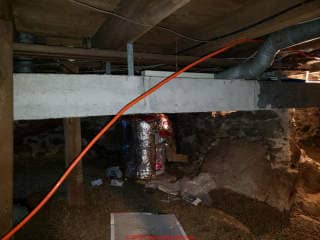
On 2019-06-18 19:24:28.969830 by (mod) -
That looks to me like transite which is an asbestos cement pipe that may have been used for a gas flue. Yours looks as if it's very deteriorated and in my opinion quite possibly unsafe. The concern would be that it could crumble and or leak harmful or even fatal flue gases into the building
On 2019-06-18 16:30:24.674368 by Jim
What is this in my exhaust for my gas furnace, just bought the house, was built in 29. Email jthebaptist66@gmail.com
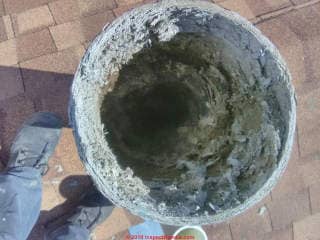
On 2019-05-16 19:13:09.931093 by (mod) -
Good going, Mike - I'd like to see a photo of what you saw when you opened the sheet metal.
In general EPA and others advise that the safest as well as least-costly treatment of asbestos materials is to leave them alone, in place, covered-over when possible.
On 2019-05-16 16:54:15.334354 by Mike
Had 2 separate asbestos contractors come out. Both said the could remove it (first contractor said $3500 the second said $1500). Both agreed that getting a look inside the duct made the most sense. Gently removed a few nails, sprayed soapy water on area and peaked in. It stopped on the joist no evidence that it encroached even a little Into the vent. Contractor said we can encapsulate the piece hanging out so it doesn’t get more disturbed. Also found some visible asbestos tape on the outside of supply vents going from basement into walls throughout the house. Not disturbed or in bad condition so neither contractor felt we needed to worry about it. All in all, worst nightmare averted.
On 2019-05-10 16:20:06.353411 by (mod) -
Thank you for the follow-up Mike, that will assist other readers. Smart you didn't take my bet.
The objective risk from un-disturbed asbestos paper duct wrap that was used as a "gasket" to seal sheet metal nailed to floor joists to form a return duct could be negligible IF the paper does not actually extend into the return air space formed by the joist sides, floor underside, and sheet metal; but to know that you'd have to inspect the duct run. You could do that by hiring an environmental specialist or just about anyone who has a duct inspection camera.
If there is ragged damaged fuzzy asbestos paper in the actual air path it'd still make sense to either abandon that duct and install separate return ducting using new materials nearby, or you'd have to treat it as an asbestos removal job, involving dust containment, removal, cleanup, testing, and restoration.
On 2019-05-10 15:48:48.984550 by Mike
Turns out it is 15% chrysotile asbestos. Just runs on the joist to seal the return from leaks.
On 2019-04-30 20:07:39.321691 by (mod) -
I'll bet a beer it's asbestos paper;
Do let me know what your test finds.
You can find asbestos test labs at the page top EXPERTS DIRECTORY
On 2019-04-30 19:26:19.639693 by Anonymous
,
Return duct is in use. I have no way to see inside to know if it’s in there too. I’m having it tested to be sure. I would obviously prefer to not have to rip down the current return If the product is not inside the duct and just have the frayed ends encapsulated.
On 2019-04-30 16:06:04.263852 by (mod) -
Actually a second look at your photo - I see that I was mistaken when I looked at it just on my phone - on the computer screen at larger magnification - and after a night's sleep - and after realizing that the photo was probably rotated counterclockwise 90 degrees by the Comments-Box software, I see
- asbestos-type insulating paper nailed to what looks like a underside of a joist, probably intending to reduce air leaks along the return duct passage
- sheet metal apparently nailed across the span between what is probably two basement ceiling joists
I suspect that this is a heating air return duct using the combination of subfloor overhead, floor joists, and sheet metal to form a duct from a floor or low-wall return air register over to a forced warm air furnace, probably built by an old-school mechanic who'd been doing return ducts this way since the 1940s.
The potential concern, though it's probably low, is the release of a bit of asbestos from the paper edges that continue under the sheet metal and into the air space and air path in the return duct.
If the return duct is not in use you'd simply cover over the asbestos-suspect paper; if it's in use you might consider changing the ductwork.
On 2019-04-30 15:49:52.209134 by Anonymous
@Mike,
,
Any chance it is just on the joist as opposed to inside the duct?
On 2019-04-29 19:27:04.243756 by Mike
Wondering what this white material is between the sheet metal and joist that makes my return vent in my 1951 home?

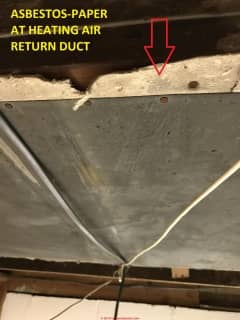 On 2019-05-10 by (mod) - 15% chrysotile asbestos confirmed in asbestos paper heating return duct
On 2019-05-10 by (mod) - 15% chrysotile asbestos confirmed in asbestos paper heating return duct
Thank you for the follow-up Mike, that will assist other readers. Smart you didn't take my bet.
The objective risk from un-disturbed asbestos paper duct wrap that was used as a "gasket" to seal sheet metal nailed to floor joists to form a return duct could be negligible IF the paper does not actually extend into the return air space formed by the joist sides, floor underside, and sheet metal; but to know that you'd have to inspect the duct run.
You could do that by hiring an environmental specialist or just about anyone who has a duct inspection camera.
If there is ragged damaged fuzzy asbestos paper in the actual air path it'd still make sense to either abandon that duct and install separate return ducting using new materials nearby, or you'd have to treat it as an asbestos removal job, involving dust containment, removal, cleanup, testing, and restoration.
On 2019-05-10 by Mike
Turns out it is 15% chrysotile asbestos. Just runs on the joist to seal the return from leaks.
On 2019-04-30 by (mod) -
I'll bet a beer it's asbestos paper;
Do let me know what your test finds.
You can find asbestos test labs at the page top EXPERTS DIRECTORY
On 2019-04-30 by Anonymous
Return duct is in use. I have no way to see inside to know if it’s in there too. I’m having it tested to be sure. I would obviously prefer to not have to rip down the current return If the product is not inside the duct and just have the frayed ends encapsulated.
On 2019-04-30 by (mod) -
Actually a second look at your photo - I see that I was mistaken when I looked at it just on my phone - on the computer screen at larger magnification - and after a night's sleep - and after realizing that the photo was probably rotated counterclockwise 90 degrees by the Comments-Box software, I see
- asbestos-type insulating paper nailed to what looks like a underside of a joist, probably intending to reduce air leaks along the return duct passage
- sheet metal apparently nailed across the span between what is probably two basement ceiling joists
I suspect that this is a heating air return duct using the combination of subfloor overhead, floor joists, and sheet metal to form a duct from a floor or low-wall return air register over to a forced warm air furnace, probably built by an old-school mechanic who'd been doing return ducts this way since the 1940s.
The potential concern, though it's probably low, is the release of a bit of asbestos from the paper edges that continue under the sheet metal and into the air space and air path in the return duct.
If the return duct is not in use you'd simply cover over the asbestos-suspect paper; if it's in use you might consider changing the ductwork.
On 2019-04-30 by Anonymous
@Mike,
Any chance it is just on the joist as opposed to inside the duct?
On 2019-04-29 by Mike
Wondering what this white material is between the sheet metal and joist that makes my return vent in my 1951 home?
On 2019-04-26 by (mod) -
Anon
If there is asbestos insulation inside of your boiler that's to be removed and if the contractors are moving it in one piece. Be able to do that by wrapping it is he said and can we get out on a hand truck. You might want to supervise a job to make sure they do what they said they're going to do.
Young. I'm worried in your behalf that the worry may have a greater health hazard for you than the asbestos concern itself
On 2019-04-26 by anonymous
hi, i have a heating unit for a 2 family house built in 1969 i am worried the unit has asbestos on the inside. My plumber told me no big deal he will wrap the unit whole in plastic but it is bolted to the basement and he has only one helper. I am worried if it shakes or bangs it will release asbestos.
The good thing its small but it could be heavy.
also there is no asbestos covering on the pipes.
The make is rusted out it looks Burnham model. I am very worried and its keeping me up at night. I dont have the extra money to use abestos expert to guide me they are extremely expensive. I was hoping you can give infomation on how to go about. laws, and to dispose of the unit in NYC Thank you please help
.
On 2019-02-07 by (mod) -
Reader follow-up:
The product is 40 years old. Is it common that deterioration may have allowed leaks to develop? Do you think it would withstand a pressure test?
Moderator reply:
I would have at least see some photos of the duct, labeling, runs, connections, and visual evidence of deterioration.
Plastic materials used in some other duct systems such as GOODMAN GRAY FLEXDUCT https://inspectapedia.com/aircond/Gray_Flex_Duct_Goodman.php ( a different design ) deteriorated badly and could be seen by visual inspection to be broken or shredded.
Fiberglass duct-board that is foil faced and whose fiberglass is fabricated far more rigid than fiberglass-insulated flexduct is also in my opinion much more durable and, properly-fabricated, less likely to be leaky.
On 2019-02-07 by (mod) - Johns-Manville “Micro-Aire FS” Fiberglas wrapped ducting - fiberglass is not an asbestos product
By private email:
Anonymous asked:
My older home (circa 1977) has Johns-Manville “Micro-Aire FS” Fiberglas wrapped ducting in the attic from my furnace
. It has an Underwriters Lab label No. 2627092 Does it contain asbestos? Is the old plastic type interior lining stable. They used this instead of galvanized duct.
Should it be replaced if I add on an AC unit?
Please let me know. Thanks,
Moderator Reply:
Here is a current Johns Manville MicroAire HVAC duct data sheet, retrieved 2019/02/06, original source: https://www.jm.com/content/dam/jm/global/en/hvac-insulation/duct-board/micro-aire/JM_HVAC_MicroAire_Mat-Faced_Data_Sheet_EN.pdf
I found no evidence that asbestos was a component in the fiberglass duct about which you asked.
Here is a representative patent
US4101700A
1976-03-12
1978-07-18
Johns-Manville Corporation
Abstract
Disclosed herein is a flexible thermally insulating duct liner comprising a fibrous thermal insulation layer having an organic fibrous layer having an open structure bonded to its working face, the working face being thereafter coated with a flame retardant vinyl polymer containing coating. The duct liner of the present invention has an extremely smooth surface which reduces air friction to a minimum. Still the product is very flexible, easy to work with, and resistant to delamination or working surface failure.
The word "asbestos" doesn't appear in the patent.
Here are all of the relevant patents I could find for Johns-Manville “Micro-Aire FS” Fiberglas wrapped ducting
pertinent J Manville Patents
US4067678A
1976-04-14
1978-01-10
Johns-Manville Corporation
Apparatus for making a fibrous board-like product having a male edge and a female edge
US4070954A
1975-10-30
1978-01-31
Glass Master Corporation
Duct forming machine
US4101700A
1976-03-12
1978-07-18
Johns-Manville Corporation
Thermally insulating duct liner
US4175159A
1978-07-31
1979-11-20
General Electric Company
Silicone emulsions for treating silicate particulate matter
US4179808A
1978-05-10
1979-12-25 Johns-Manville Corporation
Cutting guide tool for fabrication of air duct transitions and method of its use
and
Toas, Murray S., and John O. Ruid. "Moisture repellent air duct products." U.S. Patent 7,220,470, issued May 22, 2007.
includes these Non patent citatoins
Johns Manville, Fiber Glass Mat (Acrylic Binder), Material Safety Data, Sheet ID: 1014, Section 1-Chemical Product and Company Identification pp. 1-6, Oct. 21, 2002.
Johns Manville, Glass Fiber Mats, Elasti-Glass(R) 3200B Series, 1 p., Oct. 30, 2002.
Johns-Manville Fiber Glass, "Micro-Aire Duct Systems Fabrication Manual", USA.
Johns-Manville Manufacturing, "Finished Product Specification-Mat Faced Mad Board Spec No. 4365-15.6", 1971-1973, USA.
Johns-Manville Manufacturing, "Finished Product Specification-Micro-Aire Duct Board Standard Duty Heavy Duty Spec No. 4365-15", 1971-1973, USA.
Johns-Manville Manufacturing, "Product Specification-Micro-Aire Duct Board Standard Duty Heavy Duty Spec No. 4365-20", 1971-1973, USA.
Johns-Manville, "Air Handling Systems-Linacoustic RC(TM) Fiber Glass Duct Liner with Reinforced Coating System," (preliminary product information), AHS-329 Feb. 2002.
Johns-Manville, "Super Duct(TM)" Air Duct Board Fabrication Instructions, AHS-204, Feb. 1998.
Johns-Manville, Air Handling Systems-SuperDuct(TM) Coated High Performance Air Duct Board, Type 475 & 800, AHS 200 Jun. 2000.
On 2018-12-19 by (mod) - asbestos in 1990s condenser unit?
Not very likely in North America - that looks like an outdoor compressor-condenser unit, not a place where we would expect to find asbestos.
Manufacturers in nearly every country had stopped using asbestos in HVAC applications well before 1990.
On 2018-12-19 by Emanuel
Hello, do you think AC units such as the one in the image may contain asbestos inside - consider it was made in the early 90's
...
Continue reading at ASBESTOS DUCTS, HVAC or select a topic from the closely-related articles below, or see the complete ARTICLE INDEX.
Or see - more-recent questions & answers about asbestos hazards in HVAC ductwork
Or see these
Asbestos HVAC Duct Articles
- ASBESTOS HVAC DUCTS - Guide to Identification of Asbestos Materials On or In Heating and Cooling Duct Work: carbon monoxide hazards of transite chimneys and vents
- ASBESTOS TESTING LAB LIST if you need to have asbestos-suspect material tested
- DUCT SYSTEM DESIGN SIZE & DEFECTS
- DUCTWORK CONTAMINATION
- IDENTIFICATION of ASBESTOS in buildings - Asbestos Identification in buildings: How to find & identify asbestos-containing materials
- TRANSITE PIPE AIR DUCT ASBESTOS RISKS - Hazards of Asbestos-containing Transite Pipe HVAC Ducts: duct collapse, mold, radon, asbestos fiber release
- TRANSITE PIPE CHIMNEYS & FLUES - Guide to Identifying Asbestos Transite Chimneys & Flues & their Hazards in buildings
- TRANSITE PIPE WATER SUPPLY PIPING - Guide to Identifying Asbestos Cement Transite Water Pipes & their Hazards in buildings
- VIBRATION DAMPENERS - asbestos gaskets and vibration dampers in duct work
Suggested citation for this web page
ASBESTOS DUCTS, HVAC FAQs-3 at InspectApedia.com - online encyclopedia of building & environmental inspection, testing, diagnosis, repair, & problem prevention advice.
Or see this
INDEX to RELATED ARTICLES: ARTICLE INDEX to ASBESTOS HAZARDS
Or use the SEARCH BOX found below to Ask a Question or Search InspectApedia
Ask a Question or Search InspectApedia
Questions & answers or comments about asbestos materials on or inside of heating or air conditioning air ducts.
Try the search box just below, or if you prefer, post a question or comment in the Comments box below and we will respond promptly.
Search the InspectApedia website
Note: appearance of your Comment below may be delayed: if your comment contains an image, photograph, web link, or text that looks to the software as if it might be a web link, your posting will appear after it has been approved by a moderator. Apologies for the delay.
Only one image can be added per comment but you can post as many comments, and therefore images, as you like.
You will not receive a notification when a response to your question has been posted.
Please bookmark this page to make it easy for you to check back for our response.
IF above you see "Comment Form is loading comments..." then COMMENT BOX - countable.ca / bawkbox.com IS NOT WORKING.
In any case you are welcome to send an email directly to us at InspectApedia.com at editor@inspectApedia.com
We'll reply to you directly. Please help us help you by noting, in your email, the URL of the InspectApedia page where you wanted to comment.
Citations & References
In addition to any citations in the article above, a full list is available on request.
- In addition to citations & references found in this article, see the research citations given at the end of the related articles found at our suggested
CONTINUE READING or RECOMMENDED ARTICLES.
- Carson, Dunlop & Associates Ltd., 120 Carlton Street Suite 407, Toronto ON M5A 4K2. Tel: (416) 964-9415 1-800-268-7070 Email: info@carsondunlop.com. Alan Carson is a past president of ASHI, the American Society of Home Inspectors.
Thanks to Alan Carson and Bob Dunlop, for permission for InspectAPedia to use text excerpts from The HOME REFERENCE BOOK - the Encyclopedia of Homes and to use illustrations from The ILLUSTRATED HOME .
Carson Dunlop Associates provides extensive home inspection education and report writing material. In gratitude we provide links to tsome Carson Dunlop Associates products and services.


